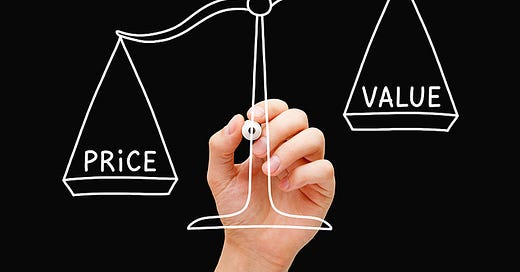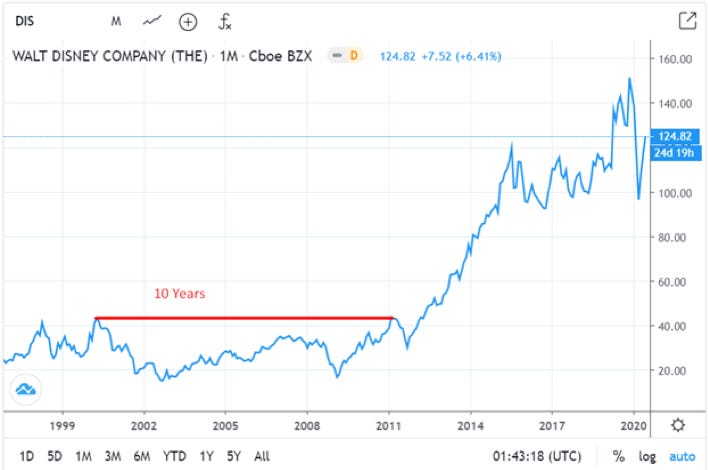"Price is what you pay, value is what you get"
Warren Buffett
Economic reality is value and is based on the economic fundamentals of a business.
Price is a barometer of the sentiment of market participants. In other words it is a momentary measure of the mood swings of Mr Market, nothing more and nothing less.
On this latter bullet point, imagine that the market had a voice. Below is a chart showing you the market capitalisation of Apple. I have imagined that Mr Market provides us with a running commentary. Read the captions that attach to the circles from left to right and you will see exactly what I mean.
Over the course of the two year period 2021 to 2023 the market couldn’t make its mind up whether Apple was worth $2 trillion, $3 trillion or something in between. Now ask yourself, did that acutal value of Apple fluctuate this much during this time?
I would suggest that the value of Apple as a business remained relatively constant throughout this period. But the price was incredibly volatile (+50% then down 30% then up again then down again).
This is so important because most people invest purely in a story: “The company is launching a new product”, “customer numbers are increasing”, “the business has signed a strategic partnership”, and so on and so forth. People hear these things and throw money at the company involved expecting a good result regardless of the price that they pay.
It was this kind of irrational thinking that pushed the Tesla price up 2,278% in two years. People bought in to all of the nonsense that Elon Musk put on Twitter. It was a classic pump and dump (insiders sold $41bn of stock in this period) but that is another story.
The point is that the value of the company cannot run so far ahead of growth in sales and earnings unless there is a ridiculous multiple expansion (read “premium being paid for the stock”).
The Tesla bubble is rapidly deflating now.
This is exactly why understanding that price matters is so important: an intelligent investor looks for a great company at the right price.
I shall demonstrate with reference to Microsoft.
Case Study: Microsoft
Microsoft has consistently been one of the best performing companies of the last 50 years, but it hasn't always been a great investment.
In the year 2000 Microsoft was the darling of the stock market. Its market capitalisation was $620 billion and it accounted for 5.3% of the value of the entire S&P500 index.
Having had its IPO in 1986 the fourteen years that followed were mind-blowing: annual growth rates were 43% for sales, 51% for earnings and 68% in terms of its market capitalisation.
The problem stemmed not from the business, which would continue growing its top and bottom lines at rates that were well in excess of other companies and of the economy as a whole. The problem was the price, which at 31 times sales and 80 times earnings, was way, way ahead of the business.
With a P/S multiple of 31x, even if Microsoft had been able to convert all of its revenue into profit (which no business ever can), investors would have seen only a 3.2% earnings yield on invested capital. That would fall far short of the hurdle rate for any rational investor.
So how much of the revenue did Microsoft convert into profit? The answer is that it had an impressive 39% net margin and so the earnings yield offered to the investor at that time was a paltry 1.25%. This is confirmed by the P/E multiple of 80x which also equates to a 1.25% earnings yield.
Who in their right mind invests in an equity offering a 1.25% return when risk-free ten year Treasuries were offering 6.03%?
"A great company at the wrong price makes for a poor investment"
Benjamin Graham
At the turn of the millennium Microsoft was a great company, but it was at the wrong price.
The primary issue is that when price runs too far ahead of value, as was the case here, there will always be a period of consolidation that follows. Either the price will drop back in line with intrinsic value, or else price will stagnate for many years until the fundamentals of the business catch up with the price.
The chart below shows how the share price trended upwards between the IPO and 2000 at an unsustainable rate, but then consolidated for 15 years thereafter. Had you invested in Microsoft in 2000 before the dotcom crash, your position would have been down until 2015 (more if you factor in the cost of capital plus equity premium).
After 2015 the share price exceeded its 2000 peak but the returns were diluted down by a decade and half of dead money. The return was a meager 5.9% CAGR over the 19 years to 2019! Ouch!
From the year 2000 until the end of 2019 Microsoft experienced outstanding growth. Revenue grew at 9.4% per year increasing from $21.8 billion to $134 billion over the period. Profits grew at 7.9% per year increasing from $8.7 billion to $41.6 billion. As an added kicker, because the company repurchased a net 26% of its outstanding shares during that period, the earnings per share grew by 9.9% per year.
Despite this, the share price massively under-performed the growth in the business because it was working-off its initial enormous overvaluation.
So despite sales increasing six-fold and profits increasing five-fold, the market cap in the same period only doubled which amounts to a capital appreciation for the poor investor of 3.6% CAGR, plus dividends which pushed the total return to 5.9% per annum.
At the turn of the millennium Microsoft was a case of the great business at the wrong price. The earnings multiple of 80x in the year 2000 was the clue for the investor. By the end of 2019 the multiple had pulled back to a more reasonable 35x, meaning that an investor lost 59.6% to multiple contraction over the period.
In other words, the 9.9% CAGR increase in earnings per share over the period was diluted because the multiple of earnings that the market was using to price the shares had fallen 59.6% - and so 59.6% of 9.9% is the 5.9% return achieved by the investor in 2019 because he overpaid for his shares in the first place!
There are countless other examples where great companies were bought at silly prices and investors had a miserable time for a decade with zero or negative returns:
Too many people invest looking in their rear-view mirror. The problem is that outsized recent gains are usually due to unjustified multiple expansion which portends a future contraction. Said differently, yesterday’s gains will be paid for by today’s investors. Don’t let that be you!
I hope that this example has hammered home that price matters really does matter for any investment. Microsoft in the year 2000 is what I term a Golden Bullet, and these ought to be avoided (click here to learn about: Golden Bullets).










